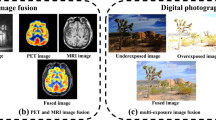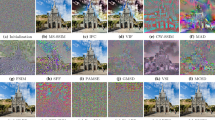Abstract
The analysis and evaluation of camouflage performance is an important procedure in digital camouflage pattern design, as it helps to improve the design quality of camouflage patterns. In this paper, we propose a novel framework that uses the nonlinear fusion of multiple image features to quantitatively evaluate the degree to which the target and surrounding background differ with respect to background-related and internal features. In our framework, background-related features are first formulated as a measure of conspicuousness, which is calculated and quantized by the saliency detection method, whereas internal features refer to the interior saliency of camouflage textures, such as lines and other regular patterns. These two features are fused to evaluate the camouflage effect. A subjective evaluation is carried out as the baseline of our evaluation model. Experimental results show that our camouflage evaluation framework accords with the human visual perception mechanism, and is an effective method for evaluating camouflage pattern design.









Similar content being viewed by others
References
Bhajantri NU, Nagabhusan P (2006) Camouflage defect identification: a novel approach. Ninth Int Conf Inf Technol. (ICIT’06) 0-7695-2635-7/06
Bian P, Jin Y, Zhangi NR (2010) Fuzzy C-means clustering based digital camouflage pattern design and its evaluation. In: IEEE 10th International Conference on Signal Processing I-III:1017-1020
Cheng MM, Zhang GX, Mitra NJ, Huang X, Hu SM (2011) Global contrast based salient region detection,” in Proc. IEEE Comp Soc Conf Comput Vis Pattern Recognit (CVPR), pp 409–416
Cui B-S, Li H-B, Fu S-W (1993) Fuzzy analysis of the target detection probability. Eng Equip Res 3(1):1–5
Feng X, Guoying C, Richang H (2014) Camouflage texture evaluation using a saliency map. Multimed Syst 21:169–175
Hough VPC (1960) Method and means for recognizing complex patterns. US Patent US3069654 A
Liming S, Weidong G (2010) A New Camouflage Texture Evaluation Method Based on WSSIM and Nature Image Features. Int Conf Multimed Technol 2010, pp 1–4
Lin W, Chen Y-H, Gao H-S (2009) Detection probability evaluation model based on texture feature of thermal infrared. Infrared Laser Eng 38(1):155–159
Liu T, Yuan Z, Sun J, Wang J, Zheng N (2011) Learning to detect a salient object. IEEE Trans Pattern Anal Mach Intell 33(2):353–365
Nyberg S, Bohman L (2001) Assessing camouflage using textural features. Proc SPIE 4370:60–71
Nyberg S, Uppsaell MS, Bohman L (2001) Approach to assessment of camouflage methodology. Proc.SPIE 1967. doi:10.1117/12.151052
Perazzi F, Krähenbül P, Pritch Y, Hornung A (2012) Saliency filters: contrast based filtering for salient region detection. IEEE CVPR 733–740
Rosten E, Mmond T (2006) Machine learning for high-speed corner detection[J]. European Conference on Computer Vision 1:430–443
Schoene R, Meidow J, Mauer E (2010) Feature evaluation for target/background discrimination in image sequence taken by approaching sensors. Proc. SPIE Int. Conf. Signal Process. Sens. Fusion Target Recognit. XIX. Orlando: SPIE,7697: 769718
Singh SK, Dhawale CA, Misra S (2013) Survey of object detection methods in camouflaged image. IERI Procedia 4:351–357
Wei L, Yu-hua C, Hong-sheng G (2007) A method of camouflage evaluation based on texture analysis model of Gabor wavelet. Acta Armamentarii 28(10):1191–1194
Wei-dong X, Liang-xu L, Cheng B, Shi-qiang X (2002) Camouflage equipment effectiveness evaluation model based on texture analysis. Acta Armamentarii 23(3):329–331
Yanhua H, Wenyuan W, Yanchun G (2011) A new method of edge camouflage evaluation based on the gray polymerization histogram. Opt Technol 37(5):601–606
Ying XU, Yao SL (2010) Optic Camouflage Effect Evaluation Method Based on Image Analyses[J]. Electro-Optic Technology Application 4:69-72
Acknowledgments
This research was supported by the National Natural Science Foundation of China (Grant Nos. 61202283 and 61472115), and the Open Project Program of the National Laboratory of Pattern Recognition (NLPR, No. 201407350).
Author information
Authors and Affiliations
Corresponding author
Rights and permissions
About this article
Cite this article
Xue, F., Yong, C., Xu, S. et al. Camouflage performance analysis and evaluation framework based on features fusion. Multimed Tools Appl 75, 4065–4082 (2016). https://doi.org/10.1007/s11042-015-2946-1
Received:
Revised:
Accepted:
Published:
Issue Date:
DOI: https://doi.org/10.1007/s11042-015-2946-1




